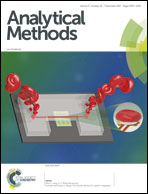A nile red-based near-infrared fluorescent probe for endogenous hydrogen polysulfides in living cells†
Abstract
Endogenous hydrogen polysulfides (H2Sn; n > 1) have attracted increasing attention because emerging studies have shown that it is actually the key signaling molecule rather than hydrogen sulfide (H2S). Therefore, developing probes for selective and sensitive detection of hydrogen polysulfides is of great significance in biological science. In this study, a new fluorescent off–on probe for the selective and sensitive detection of hydrogen polysulfides (H2Sn) with near-infrared (NIR) fluorescent signal change has been designed and synthesized. The probe was synthesized by an esterification reaction coupling between a nile red dye and a bis-electrophilic H2Sn capture group 2-fluoro-5-nitrobenzoic acid. The probe showed a specific off–on response to H2Sn in aqueous solution with nanomolar LOD without interference by a range of competing sulfocompounds and several reactive nitrogen and oxygen species. Moreover, it can be used for imaging of endogenous H2Sn in living cells.



 Please wait while we load your content...
Please wait while we load your content...